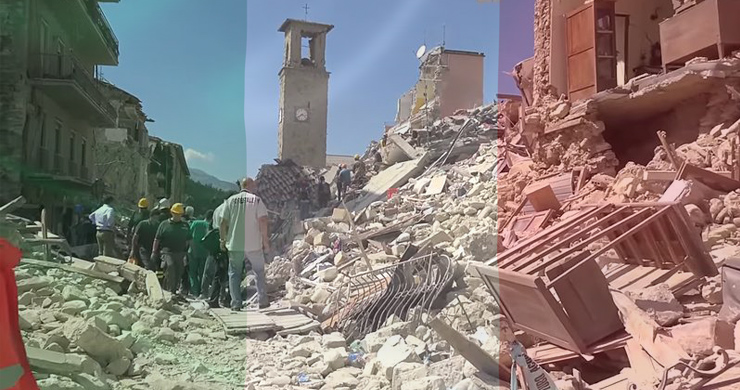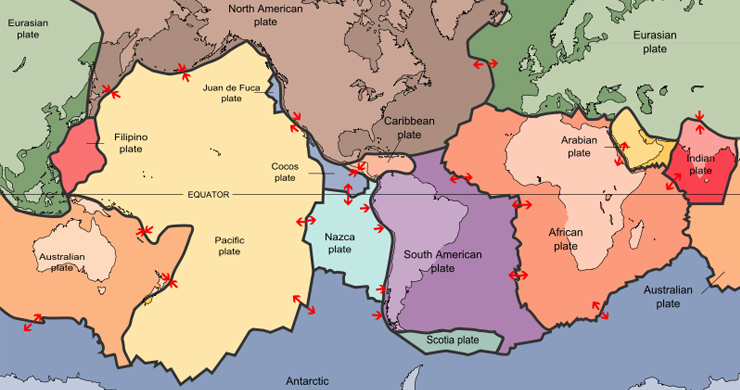Overview of different Types of Plate Boundaries
Different Types Of Plate Boundaries
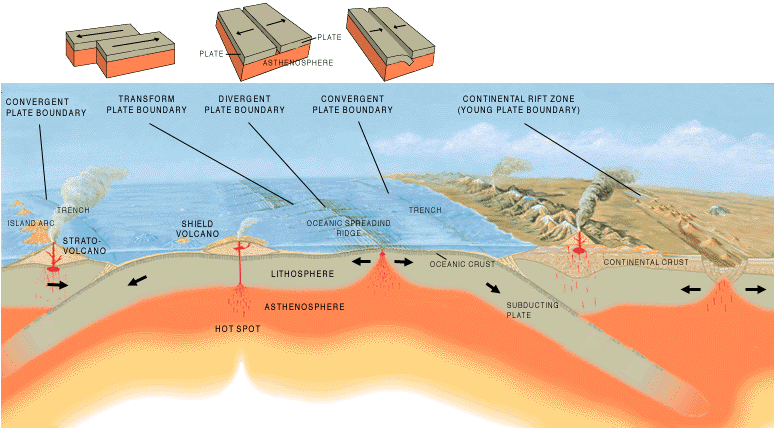
Image: Tectonic plate boundaries - Jose F. Vigil. USGS © Public Domain
In linked article 2 we started to think about the different boundaries that exist where tectonic plates meet. In this article we will investigate them in more detail.
Remember the structure of the earth; that the rigid plates (crust and upper mantle) move on convection currents in the hotter and softer rocks of the mantle below them.
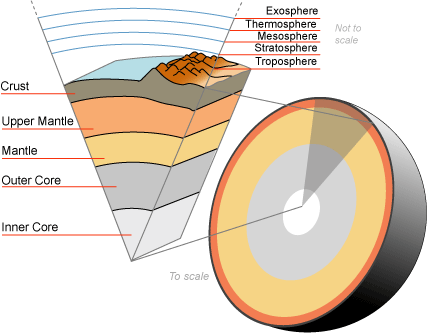
Image: Earth-crust-cutaway-english - Jeremykemp © Public Domain
Different Terminology
Depending on the different processes taking place similar places may have different terms used to describe them. In this article we will try and give you the main names used and what they mean.
Divergent Boundary
When two plates move apart the boundary will commonly have one of three names:
- Divergent Boundary (diverge means to move apart).
- Tensional Boundary (tension pulls apart).
- Constructive Boundary (as new crustal material can form here).
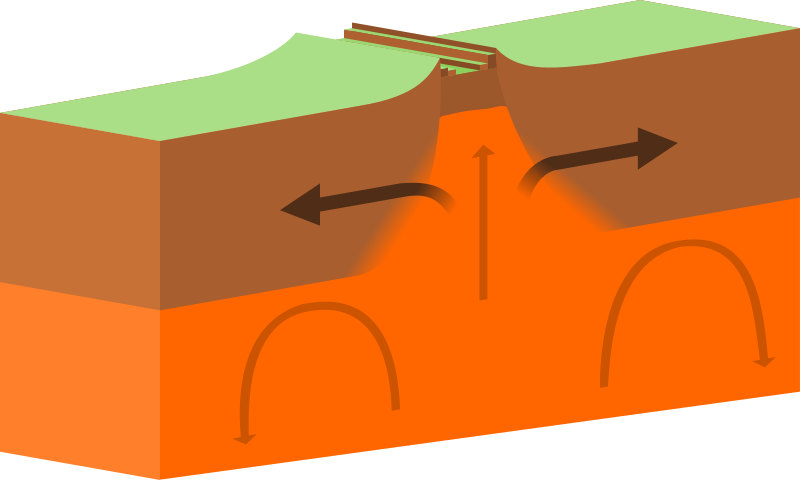
Image: Continental-continental constructive plate boundary - domdomegg © Wikimedia Commons under Creative Commons Attribution-Share Alike 4.0 International
A good example of a divergent boundary is the Mid-Atlantic Ridge.
The Mid-Atlantic Ridge lies between the North American and Eurasion Plate in the North Atlantic and between the South American and African Plates in the South Atlantic.
The distance between them grows at a speed of approximately 5-7cm per year.
In the North Atlantic the volcanic rocks of the ridge have pushed above the surface of the sea to form Iceland.
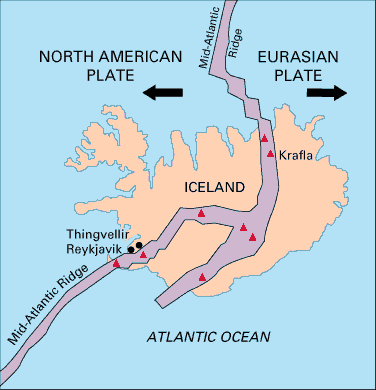
Image: Iceland Mid-Atlantic Ridge Fig16 - USGS © Public Domain
Another good example of a tensional boundary is where East Africa is being pulled apart by currents below it forming a new ‘Rift’ valley that will form a new ocean over the next few million years.
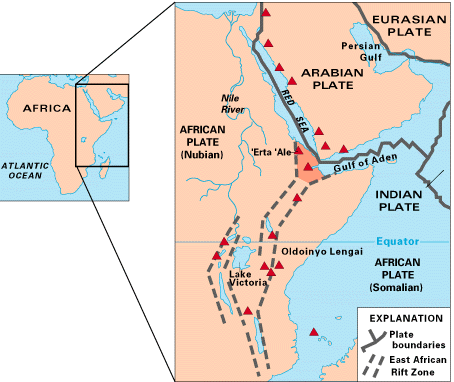
Image: EAfrica - USGS © Public Domain
As the plate is pushed up and pulled apart weaknesses break called normal faults. As the plate is pulled further apart blocks sink downwards along these normal faults causing valleys called rift valleys separated by blocks.
Think about it like this:
- Upwards current in the mantle push overlying layers upwards to form a ridge several thousand metres high.
- Faults form by the rocks breaking as they are being pushed upwards.
- The currents pull the surface layers apart.
- Blocks drop down between the faults to form rift valleys.
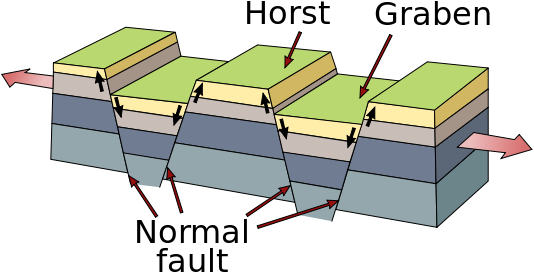
Image: Fault-Horst-Graben - USGS / Gregors © Public Domain
In this image of East Africa the Rift Valleys are being filled by lakes. You can clearly see the lines of the normal faults.
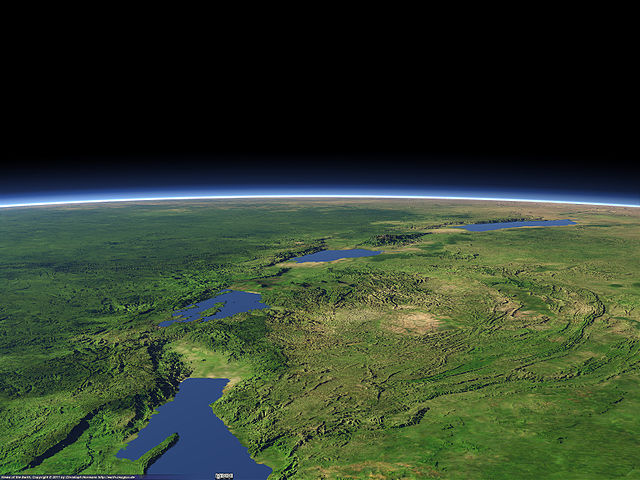
Image: Albertine Rift, East African Rift (artificial rendering) - Christoph Hormann © Wikimedia Commons under Creative Commons Attribution-Share Alike 3.0 Unported
Eventually a new sea and then an ocean will be created where these lakes are now.
Volcanoes happen at tensional boundaries because as mantle rocks rise upwards the pressure on them from overlying layers decreases.
As pressure drops about 10% of the mantle rocks melt to form a magma rich in Silica and Magnesium.
The magma squeezes up along faults and cracks to reach the surface and become lava and new crust.
These new rocks are sometimes called oceanic crust as they mostly form beneath the oceans and seas.
Oceanic crust cools quickly because of the waters; it forms cracks filled with sea water.
The minerals that form oceanic crust are much denser than in other surface rocks.
Convergent Boundary
When two plates move together the boundary will commonly have one of three names:
- Convergent Boundary (converge means to move together).
- Compressional Boundary (compression pushes together).
- Destructive Boundary (as crustal material can be melted here).
If one of the plates is made up of oceanic crust then it can be forced downwards into the mantle where parts of it will melt.
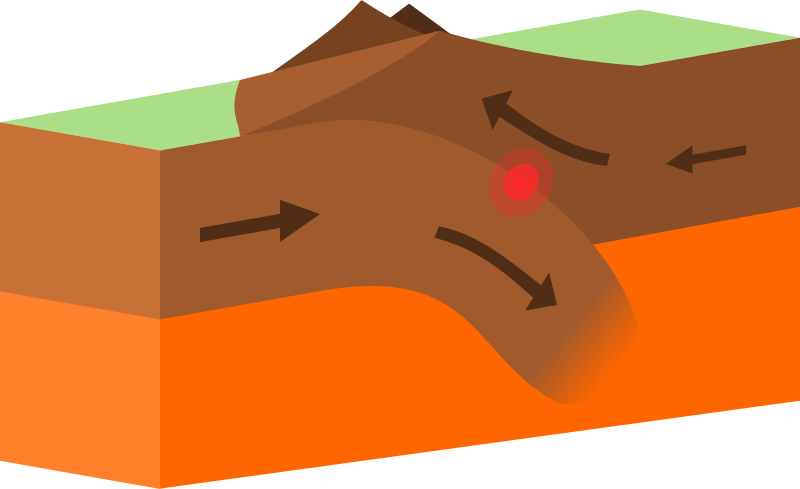
Image: Continental-continental destructive plate boundary - domdomegg © Wikimedia Commons under Creative Commons Attribution-Share Alike 4.0 International
Oceanic crust is formed mostly at tensional boundaries (some is formed by ‘hotspots’ in the mantle that can create volcanoes such as Hawaii).
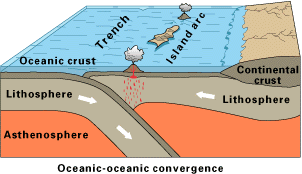
Image: Oceanic-oceanic convergence - USGS © Public Domain
When two plates made up of oceanic crust are forced together then one of them will be forced downwards into the mantle. This is called subduction.
When subduction happens a deep trench is formed as surface layers are dragged downwards.
The oceanic crust has lots of cracks within it filled with seawater.
The seawater lowers the melting point of some of the minerals causing these to melt and form magma.
This magma is less dense than surrounding rock layers so it rises and cools.
This magma is different from oceanic crust as it is rich in silica and aluminium (instead of magnesium) it will form the types of rocks called continental crust.
Continental crust is much less dense than oceanic crust which means it cannot sink back into the mantle (subduction).
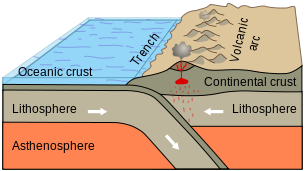
Image: Active Margin - Booyabazooka © Public Domain
When a plate made up of oceanic crust is forced into a plate made up of continental crust the oceanic crust plate will be forced downwards into the mantle (subduction) this is just the same as the example above.
Rising magma will be formed in the same way but as it rises it starts to absorb the overlying continental crust. This creates a very thick, sticky magma which is explosive if it reaches the surface (becomes lava).
The overlying continental rocks will also be folded and pushed upwards to make fold mountains.
An excellent example of this is along the Western edge of the South American Plate.
In the satellite image you can see the deep blue colour showing the trench.
The reddish colours show the Andes Mountains.
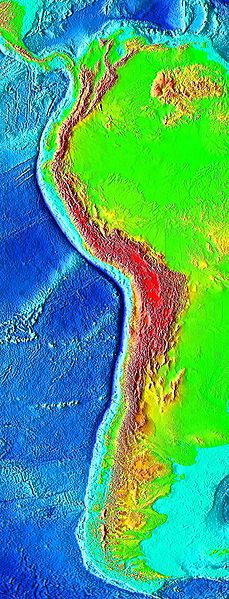
Image: Peru-Chile trench - Interiot~commonswiki © Public Domain
The Andes are the longest continental mountain range in the world; they are about 7,000 km long.
The average height is about 4,000 metres. The highest mountain is called Acongagua at 6,961 metres. This is the highest mountain outside of the Himalayas.
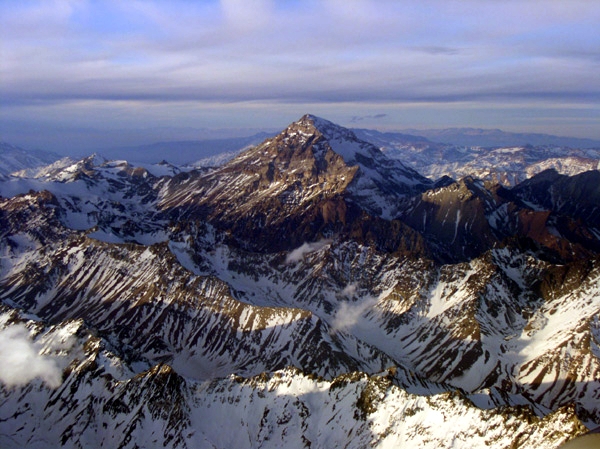
Image: Aconcagua (aerial) - Beatriz Moisse © Wikimedia Commons under Creative Commons Attribution-Share Alike 3.0 Unported
The Andes extend from north to south through seven South American countries: Venezuela, Colombia, Ecuador, Peru, Bolivia, Chile and Argentina.
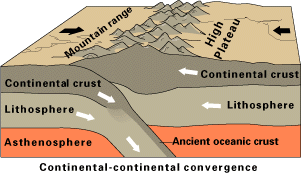
Image: Continental-continental convergence - USGS © Public Domain
When two plates with continental crust collide they are much less dense than the underlying mantle rocks so they cannot be subducted.
As a result the rocks are folded and forced upwards to form a fold mountain chain such as the Himalayas. A period of mountain building is called an orogeny (can you find this term in article 2?).
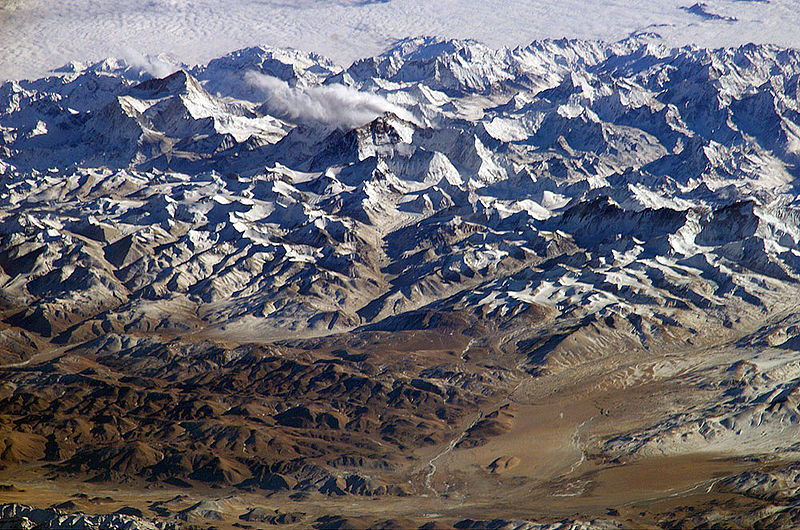
Image: Himalayas - NASA © Public Domain
The Himalayas are found in a belt between the Indian sub-continent to the South and China on the Eurasian Plate to the North.
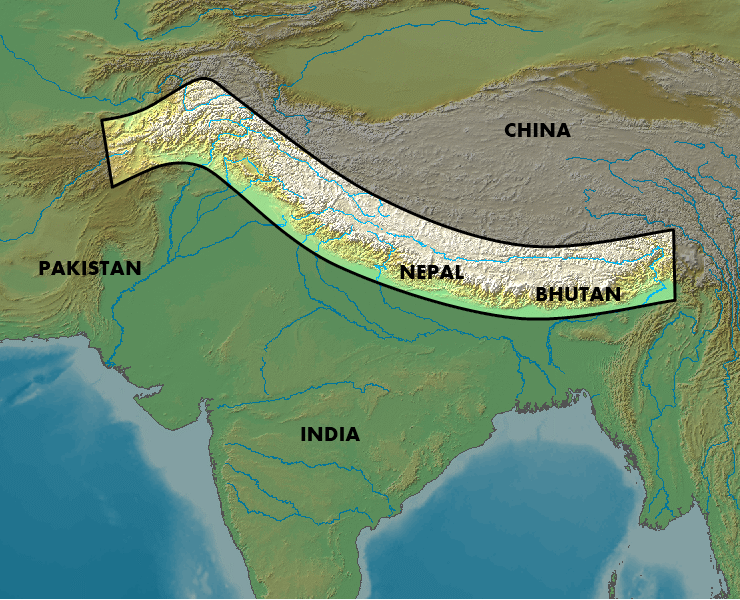
Image: Himalayas Map - Sven Manguard © Public Domain
The Himalayas were formed as the Indian Plate moved northwards colliding with the Eurasian Plate. This is still happening today so the mountains are still building.
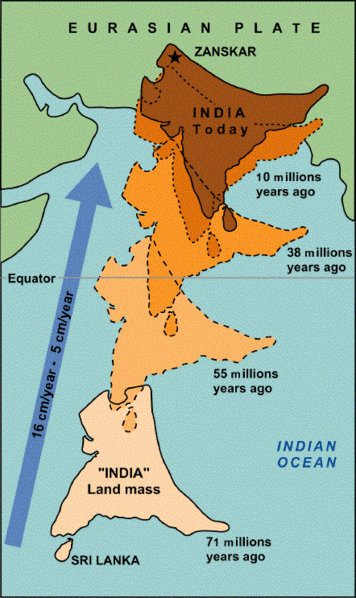
Image: India 71-0 Ma - Mourmine / http://comp1.geol.unibas.ch/zanskar/ © Wikimedia Commons
Conservative Boundary
When plates are not moving together or apart they are known as either a conservative or passive boundary.
If they are moving in opposite directions they may be called a transform fault.
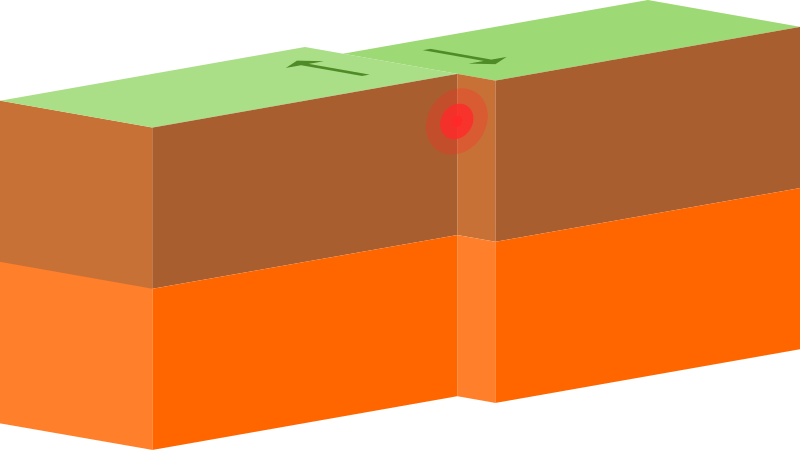
Image: Continental-continental conservative plate boundary opposite directions - domdomegg © Wikimedia Commons under Creative Commons Attribution-Share Alike 4.0 International
The main features along this kind of boundary are small compared to the other types of boundaries. However they can have some powerful earthquakes along them so it is important to know where they are.
© H. H. Khan
© Bozeman Science
Student Activity
Use the resource sheet to provide a diagram for each of the main types of plate boundary.
Explain what is happening either with a bullet point list or with annotations on and around the diagram.
After reading all three articles and carrying out the activities. Use the accompanying A3 sheet to help you to start a DME into tectonic hazards. The DME will be completed with the next edition of GITN.
